Use of rice and wheat bran as organic carbon sources supports significant control of nitrogen compounds and enhanced production in L. vannamei nursery systems
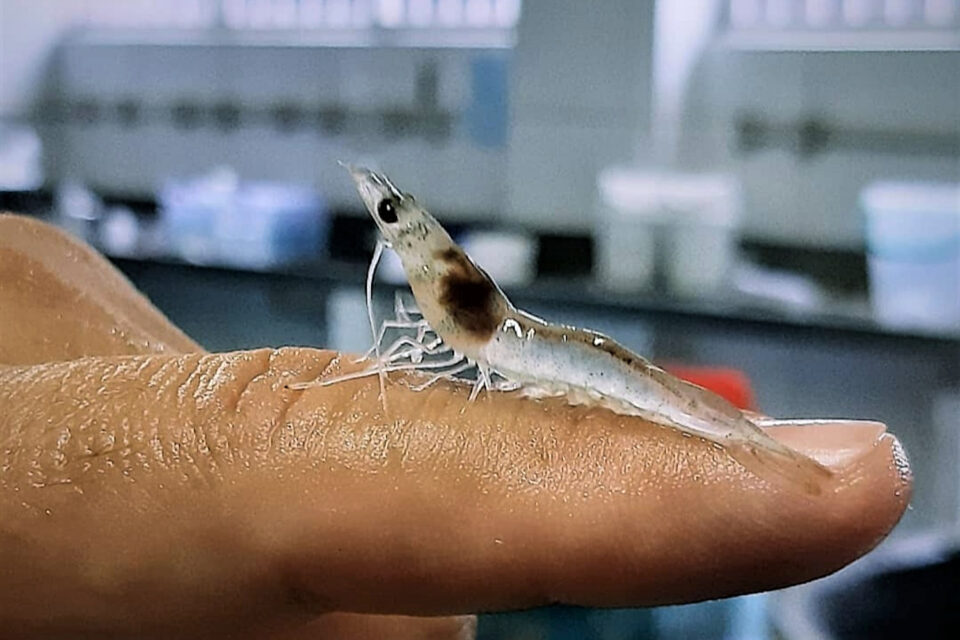
In Pacific white shrimp (Litopenaeus vannamei) intensive farming systems with minimal water exchange, the microbial community (heterotrophic and nitrifying bacteria) is stimulated by the organic carbon supply in the water that supports the transformation of nitrogenous compounds into less toxic compounds (i.e., nitrate) and also into microbial biomass. Several organic carbon sources have been used (including molasses, vegetable bran, dextrose and sugar) to stimulate bacterial growth. However, in recent years, new strategies like synbiotics have been incorporated into intensive aquaculture production, which are considered to have high potential for shrimp culture.
Synbiotic systems result from anaerobic and/or aerobic processes carried out by microorganisms (probiotics) on a vegetable or animal substrates, bran and other carbohydrates (prebiotics). Thus, probiotic microorganisms promote the breakdown of organic complex molecules into simpler molecules and provide balanced amounts of micronutrients and macronutrients to the animals in the aquaculture system. Moreover, there is substantial production of organic acids, such as lactic, acetic and butyric acids. This strategy provides a greater balance between the microorganisms and a lower supply of organic carbon in the system.
This article presents the results of a study that evaluated the effects of anaerobic and aerobic processes using rice bran and wheat bran as organic carbon sources (synbiotic) on the growth of L. vannamei postlarvae (PL) in seawater and low salinity water nursery systems.
Study setup
The studies were carried out at the Rural Federal University of Pernambuco, Recife, Brazil, with three trials with seawater and low salinity water. For the seawater trial, a water tank with a salinity of 35 grams per liter (g/L) was chlorinated with 13 mg/L of chlorine and dechlorinated by aeration for 72 hours. Then an inorganic fertilization treatment with urea (4.5 g N/m³), triple superphosphate (0.3 g P/m³) and sodium silicate (0.23 g Si/m³) was applied. In the low salinity water trial, a tank containing seawater diluted in freshwater to a salinity of 2 g/L was chlorinated with 13 mg/L of chlorine, and dechlorinated by aeration during 72 hours. Then, the organic fertilization was carried out as for the seawater trial.
L. vannamei postlarvae, 10 to 24 days old (PL10-24), were stocked at a density of 2,000 to 3,000 shrimp/m³ in experimental units (40 and 60-L of useful volume). The PL were fed with a commercial shrimp feed (45 percent crude protein and 9.5 percent lipids) four times a day. The feeding rate was adjusted weekly based on shrimp growth, estimated consumption and mortality.
To evaluate the shrimp zootechnical performance, at the end of each trial, the animals were weighed to determine their final weight (g), feed conversion rate (FCR), yield (Kg/m³) and survival rate (percent).
Some water quality variables in the experimental units, such as dissolved oxygen (DO, mg/L), temperature (degrees-C) and salinity (g/L), were monitored daily. Other water quality variables like total ammonia nitrogen (TAN, mg/L), nitrite-N (NO2–-N, mg/L) and alkalinity (mg CaCO3/L) were measured weekly.
First trial
Organic fertilization was carried out with about 10 applications of the fertilizer. The fertilizer was processed through an anaerobic phase for 48 hours and an aerobic phase for 24 hours. During the experimental time, the fertilizer was added to the experimental units every three days during the 42 days of the trial. The organic fertilizer was composed of wheat bran (50 to 22.5 g/m³), molasses (25 to 12 g/m³) and sodium bicarbonate (10 to 4.5 g/m³). We also added (at 0.5 g/m³) a commercial (Kayros Ambiental and Agrícola, Brazil) bacteria-based product containing Bacillus subtilis, B. licheniformis, Lactobacillus sp., Saccharomyces sp. and Pseudomonas sp. strains at 7.7 x 108 CFU (colony forming units) per gram and previously chlorinated seawater.
Second trial
Organic fertilization was carried out through about 10 applications of the fertilizer. The fertilizer was processed through an anaerobic phase for 24 hours and an aerobic phase for 24 hours. During the experimental time, the fertilizer was added to the experimental units every three days during the 42 days of the trial. The organic fertilizer was composed of rice bran (< 200 μm, 20 g/m³), molasses (2 g/m³), sodium bicarbonate (4 g/m³). We also added (at 0.5 g/m³) the commercial (Kayros Ambiental and Agrícola, Brazil) bacteria-based product containing Bacillus subtilis, B. licheniformis, Lactobacillus sp., Saccharomyces sp. and Pseudomonas sp. strains at 5.5 to 6.5 x 107 CFU per gram and previously chlorinated seawater.
Third trial
Organic fertilization was carried out through about 8 to 10 applications of the fertilizer. The fertilizer was processed through an anaerobic phase for 24 hours and an aerobic phase for 24 hours. During the experimental time, the fertilizer was added to the experimental units every three days during the 40 days of the trial. The organic fertilizer was composed by rice bran < 200 μm (20 g/m³), molasses (2 g/m³), sodium bicarbonate (4 g/m³).
We also added (at 0.5 g/m³) the commercial (Kayros Ambiental and Agrícola, Brazil) bacteria-based product containing Bacillus subtilis, B. licheniformis, Lactobacillus sp., Saccharomyces sp. and Pseudomonas sp. strains at 6.5 x 107 CFU per gram and previously chlorinated freshwater. In addition, in this trial and to support the microbial community development and the nitrification process in the experimental units, we added shells of the bivalve Anomalocardia brasiliana as artificial substrate (covering about 28 percent of the bottom (25 x 24 x 5 cm) area, and corresponding to 3.36 percent of the useful volume), in addition to reusing about 15 percent of the water in the shrimp nursery.
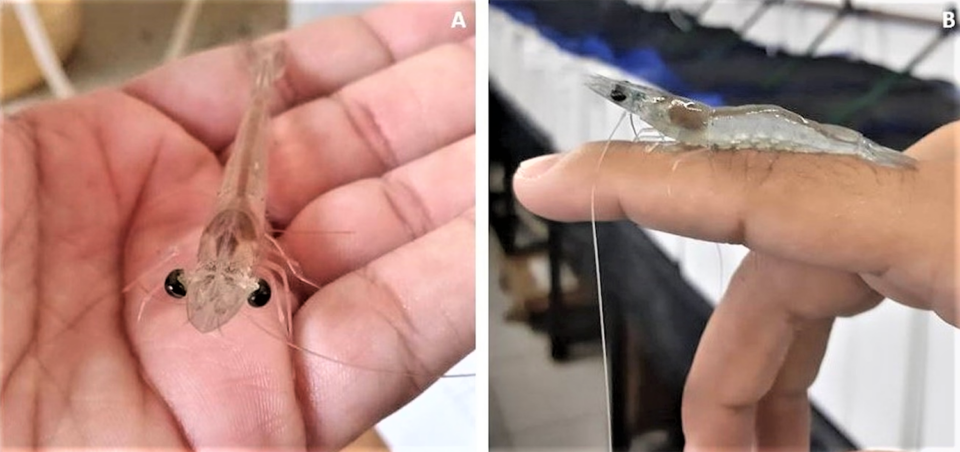
Results and discussion
The water quality variables in the nurseries remained within the recommended range for intensive shrimp nurseries (Table 1). Mean values were ≈ 30.0 degrees-C for water temperature; DO levels over 5.0 mg/L; TAN levels of 0.33 to 0.60 mg/L; NO2 – N levels of 0.41 to 1.56 mg/L; and alkalinity over 95 mg CaCO3/L.
Brito, Nursery trials, Table 1
| Variables | Trial 1 | Trial 2 | Trial 3 |
|---|
Variables | Trial 1 | Trial 2 | Trial 3 |
|---|---|---|---|
| TAN (mg/L)) | 0.30 ± 0.11 | 0.60 ± 0.36 | 0.33 ± 0.54 |
| NO2 – N (mg/L) | 1.10 ± 0.49 | 1.56 ± 0.92 | 0.41 ± 0.13 |
| Alkalinity (mg CaCO3/L) | 118.34 ± 16.50 | 128.31 ± 3.08 | 95.47 ± 41.04 |
The shrimp zootechnical performance data in the synbiotic nursery with seawater and low salinity water conditions at days 40-42 are presented in Table 2. Survival rates were over 84 percent, final shrimp weights were 0.85 – 0.98 grams, and mean feed conversion rates were 1.20 – 1.34 while reaching a shrimp yield of 1.53 – 2.50 Kg/m³ (Table 2).
Brito, Nursery trials, Table 2
| Variables | Trial 1 | Trial 2 | Trial 3 |
|---|
Variables | Trial 1 | Trial 2 | Trial 3 |
|---|---|---|---|
| Final weight (g) | 0.98 ± 0.16 | 0.96 ± 0.31 | 0.85 ± 0.37 |
| Yield (Kg/m3) | 2.48 ± 0.03 | 2.50 ± 0.86 | 1.53 ± 0.71 |
| Survival (%) | 84.45 ± 10.54 | 92.54 ± 4.47 | 89.01 ± 5.60 |
| FCR | 1.28 ± 0.27 | 1.20 ± 0.26 | 1.34 ± 0.50 |
Based on our study results, we showed that the combination of anaerobic and aerobic processing of wheat bran and rice bran by microorganisms and their use as an organic carbon source, and also the use of artificial substrate in L. vannamei nurseries are a viable alternative for synbiotic system fertilization using minimal water exchange. This approach allows greater control of total ammonia nitrogen and nitrite-nitrogen in seawater and low salinity water systems, unlike what happens in intensive systems with minimal water exchange with low salinity, which have shown high mortality to the cultured shrimp due to the toxicity of these nitrogen compounds.
Overall, our results demonstrated that the use of the water fertilization method we used contributes positively to the growth of beneficial heterotrophic and nitrifying bacteria and thus supports improved shrimp growth and survival in seawater and low-salinity water conditions.
Perspectives
The results of our study show that the combined administration of vegetable bran (anaerobic and aerobic) as an organic carbon source and probiotics (synbiotic), artificial substrate and water reuse provides significant control of nitrogen compounds (TAN and NO2–-N) and positive effects on the growth of Litopenaeus vannamei in nurseries with seawater and low-salinity water.
References available from the corresponding author.
Now that you've reached the end of the article ...
… please consider supporting GSA’s mission to advance responsible seafood practices through education, advocacy and third-party assurances. The Advocate aims to document the evolution of responsible seafood practices and share the expansive knowledge of our vast network of contributors.
By becoming a Global Seafood Alliance member, you’re ensuring that all of the pre-competitive work we do through member benefits, resources and events can continue. Individual membership costs just $50 a year.
Not a GSA member? Join us.
Authors
-
Luis Otavio Brito da Silva, Ph.D.
Professor
Corresponding author
Departamento de Pesca e Aquicultura
Universidade Federal Rural de Pernambuco
Recife, Brazil -
Allyne Elins Moreira da Silva, M.Sc.
Departamento de Pesca e Aquicultura
Universidade Federal Rural de Pernambuco
Recife, Brazil -
Caio Rubens do Rêgo Oliveira
Master’s degree student
Departamento de Pesca e Aquicultura
Universidade Federal Rural de Pernambuco
Recife, Brazil -
Danielle Alves da Silva, M.Sc.b
Departamento de Pesca e Aquicultura
Universidade Federal Rural de Pernambuco
Recife, Brazil -
Elizabeth Pereira dos Santos, M.Sc.
Departamento de Pesca e Aquicultura
Universidade Federal Rural de Pernambuco
Recife, Brazil -
Otávio Augusto Lacerda Ferreira Pimentel, M.Sc.
Departamento de Pesca e Aquicultura
Universidade Federal Rural de Pernambuco
Recife, Brazil -
Priscilla Celes Maciel de Lima, M.Sc.
Departamento de Pesca e Aquicultura
Universidade Federal Rural de Pernambuco
Recife, Brazil -
Rildo José Vasconcelos de Andrade, M.Sc.
Departamento de Pesca e Aquicultura
Universidade Federal Rural de Pernambuco
Recife, Brazil -
Valdemir Queiroz de Oliveira, M.Sc.
Departamento de Pesca e Aquicultura
Universidade Federal Rural de Pernambuco
Recife, Brazil; and
Embrapa Meio-Norte
Parnaíba, Brazil -
Suzianny Maria Bezerra Cabral da Silva, Ph.D.
Professor
Departamento de Pesca e Aquicultura
Universidade Federal Rural de Pernambuco
Recife, Brazil -
Alfredo Olivera Gálvez, Ph.D.
Professor
Departamento de Pesca e Aquicultura
Universidade Federal Rural de Pernambuco
Recife, Brazil
Tagged With
Related Posts

Responsibility
A look at various intensive shrimp farming systems in Asia
The impact of diseases led some Asian shrimp farming countries to develop biofloc and recirculation aquaculture system (RAS) production technologies. Treating incoming water for culture operations and wastewater treatment are biosecurity measures for disease prevention and control.
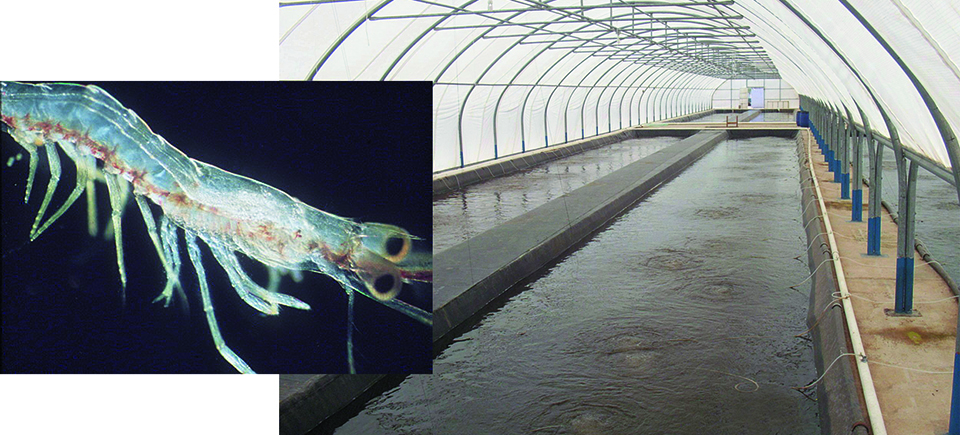
Health & Welfare
New nursery diet for shrimp performs well at super-high stocking densities
A shrimp diet developed in trials is the first dry nursery diet shown to ensure good performance at stocking densities up to 45,000 per square meter.
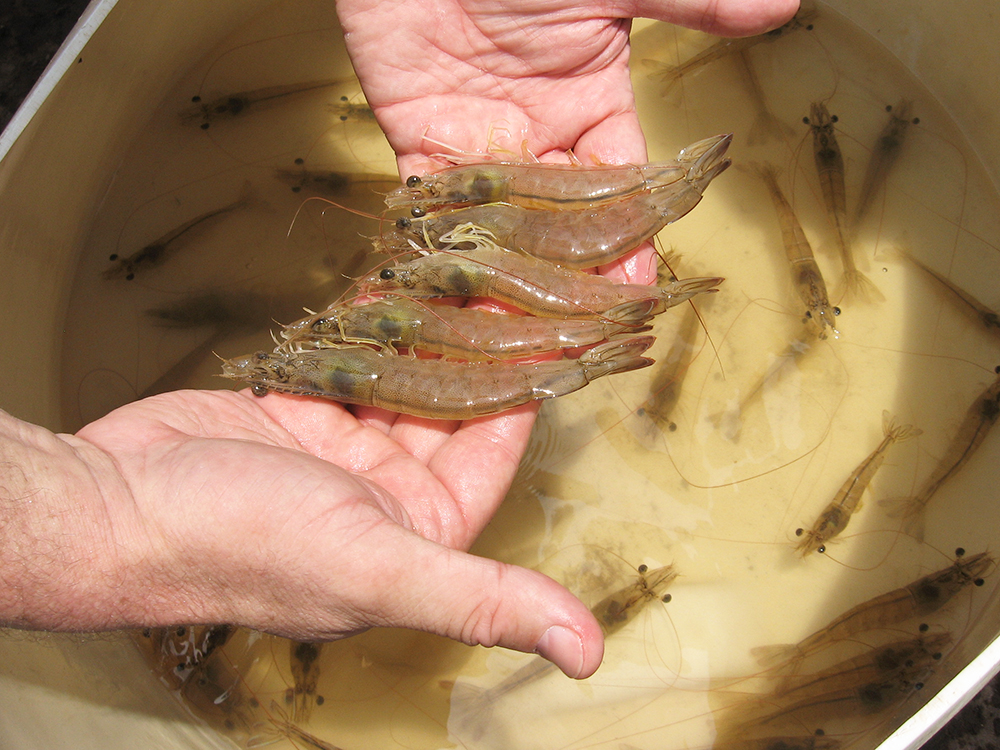
Intelligence
We can grow better shrimp, and in better ways
The recent Central American Aquaculture Symposium in Choluteca, Honduras, brought together more than 600 participants to discuss industry issues and perspectives. The focus was shrimp diseases and their impacts on production, as well as practical alternatives to face these issues and move forward.
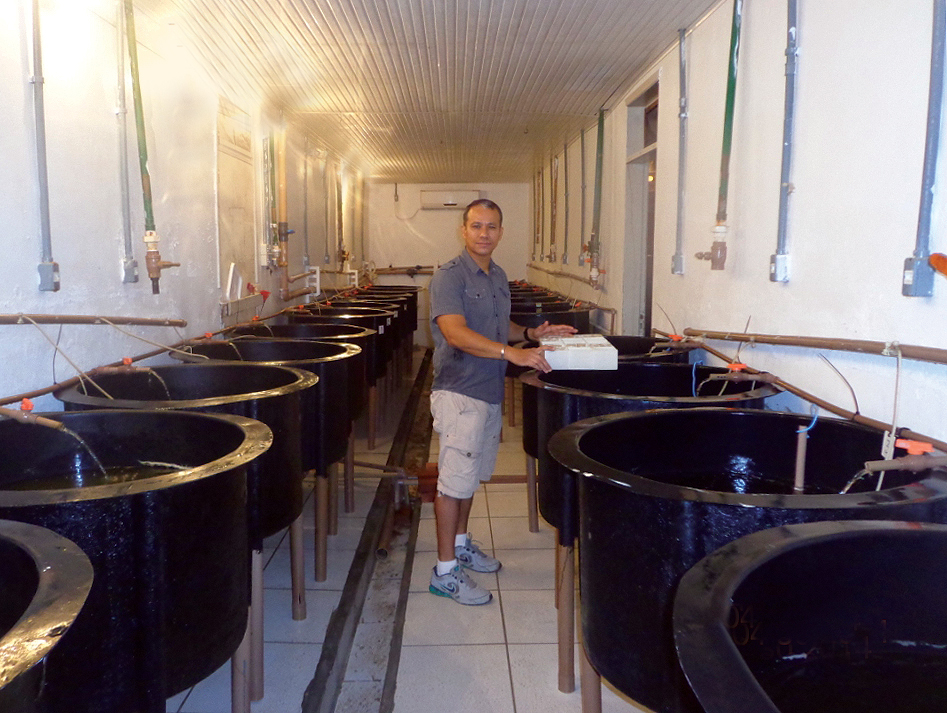
Health & Welfare
Stocking density affects super-intensive biofloc nursery shrimp production
The authors performed a study to determine the tolerance of shrimp postlarvae to the crowding effects of high-density stocking in terms of production performance. Postlarvae were stocked in heavily aerated microcosm tanks with biofloc at 1,500; 3,000; 6,000 or 9,000 shrimp/m3. High survival was observed at all densities. Final biomass values increased with higher stocking densities, but there was no significant difference between the 6,000 and 9,000 shrimp/m3 treatments or the 1,500 and 3,000 shrimp/m3 treatments.



